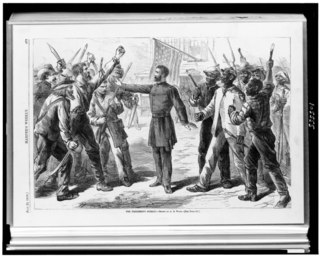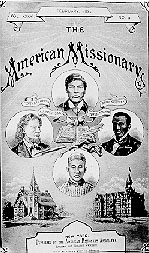
Mixed-sex education, also known as mixed-gender education, co-education, or coeducation, is a system of education where males and females are educated together. Whereas single-sex education was more common up to the 19th century, mixed-sex education has since become standard in many cultures, particularly in western countries. Single-sex education remains prevalent in many Muslim countries. The relative merits of both systems have been the subject of debate.

The Bureau of Refugees, Freedmen, and Abandoned Lands, usually referred to as simply the Freedmen's Bureau, was a U.S. government agency of early post American Civil War Reconstruction, assisting freedmen in the South. It was established on March 3, 1865, and operated briefly as a federal agency after the War, from 1865 to November 1872, to direct provisions, clothing, and fuel for the immediate and temporary shelter and supply of destitute and suffering refugees and freedmen and their wives and children.

The American Missionary Association (AMA) was a Protestant-based abolitionist group founded on September 3, 1846 in Albany, New York. The main purpose of the organization was abolition of slavery, education of African Americans, promotion of racial equality, and spreading Christian values. Its members and leaders were of both races; the Association was chiefly sponsored by the Congregationalist churches in New England. The main goals were to abolish slavery, provide education to African Americans, and promote racial equality for free Blacks. The AMA played a significant role in several key historical events and movements, including the Civil War, Reconstruction, and the Civil Rights Movement.

Education in the Thirteen Colonies during the 17th and 18th centuries varied considerably. Public school systems existed only in New England. In the 18th Century, the Puritan emphasis on literacy largely influenced the significantly higher literacy rate of the Thirteen Colonies, mainly New England, in comparison to Britain and France.
The history of education in the United States covers the trends in formal education in America from the 17th century to the early 21st century.

This is a selected bibliography of the main scholarly books and articles of Reconstruction, the period after the American Civil War, 1863–1877.
Education in Arkansas covers the history and current status of education at all levels, public and private, and related policies.
Education in North Carolina covers public and private education at all levels since the colonial era.
Education in South Carolina covers the history and current status of education at all levels, public and private, and related policies.
In the early colonial history of the United States, higher education was designed for men only. Since the 1800s, women's positions and opportunities in the educational sphere have increased. Since the late 1970s and early 1980s, women have surpassed men in number of bachelor's degrees and master's degrees conferred annually in the United States and women have continuously been the growing majority ever since, with men comprising a continuously lower minority in earning either degree. The same asymmetry has occurred with Doctorate degrees since 2005 with women being the continuously growing majority and men a continuously lower minority.
The civil rights movement (1865–1896) aimed to eliminate racial discrimination against African Americans, improve their educational and employment opportunities, and establish their electoral power, just after the abolition of slavery in the United States. The period from 1865 to 1895 saw a tremendous change in the fortunes of the Black community following the elimination of slavery in the South.
Formal education in Mississippi began in the early 19th century with private schools and academies, a public education system was founded during the Reconstruction era, by the biracial legislature led by the Republican Party. Throughout its history, Mississippi has produced notable education inequalities due to racial segregation and underfunding of black schools, as well as rural zoning and lack of commitment to funding education.
David B. Tyack was the Vida Jacks Professor of Education and Professor of History, Emeritus at the Stanford Graduate School of Education. Tyack is known for his wide-ranging studies and interpretations of the history of American education.
The history of higher education in the United States begins in 1636 and continues to the present time. American higher education is known throughout the world for its dramatic expansion. It was also heavily influenced by British models in the colonial era, and German models in the 19th century. The American model includes private schools, mostly founded by religious denominations, as well as universities run by state governments, and a few military academies that are run by the national government.

The history of education in Missouri deals with schooling over two centuries, from the settlements In the early 19th century to the present. It covers students, teachers, schools, and educational policies.

Freedmen's Schools were educational institutions created soon after the abolition of slavery in the United States to educate freedmen. Due to the remaining opposition to equality between blacks and whites, it was difficult for the formerly enslaved to receive a proper education, among a myriad of other things. Schools were made especially for blacks but were open to anyone regardless of race. These schools were far from perfect; however, they did give African Americans hope and opportunity for their future.
The history of education in New York City includes schools and schooling from the colonial era to the present. It includes public and private schools, as well as higher education. Annual city spending on public schools quadrupled from $250 million in 1946 to $1.1 billion in 1960. It reached $38 billion in 2022, or $38,000 per public school student. For recent history see Education in New York City.
History of education in the Southern United States covers the institutions, ideas and leaders of schools and education in the Southern states from colonial times to about the 2000s. It covers all the states and the main gender, racial and ethnic groups.
History of education in Kentucky covers education at all levels from the late 18th century to the early 21st century. The frontier state was slow to build an educational system. In K–12 and higher education, Kentucky consistently has ranked toward the bottom of national rankings in terms of funding, literacy levels, and student performance. Inside the state the Appalachian region always lagged. The Bluegrass area, however, built a strong reputation in higher education.
The History of African-American education deals with the public and private schools at all levels used by African Americans in the United States and for the related policies and debates. Black schools, also referred to as "Negro schools" and "colored schools", were racially segregated schools in the United States that originated in the Reconstruction era after the American Civil War. They were created in Southern states under biracial Republican governments as free public schools for the formerly enslaved. All their students were blacks. After 1877, conservative whites took control across the South. They continued the black schools, but at a much lower funding rate than white schools.






